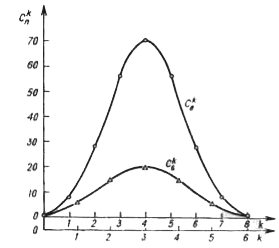A vessel of capacity V0 contains n molecules. Calculate the probability of all the molecules assembling in a part of the vessel V<V0.
The correct Answer is:wn=(V/V0)n
First method. Since both parts of the vessel are equivalent (this is the consequence of the homogeneity and the isotropy of space) the probability of finding a particle inside a volume V<V0 is equal to the ratio of volumes:
p=VV0,q=1−p=V0−VV0

In the present problem k = n, i.e. all the molecules are contained inside V. The answer is obtained from the solution of Problem 18.5. For a large number of molecules the probability of such an event is negligible.
Second method. The problem may be solved without the binomial distribution, bul directly on the basis of the theorem for compound probability. Spocificully, the probability of finding a molecule inside the given volume is p=V/V0). The probability of finding simultaneously all the n molecules in it is the product of the individual probabilities : w=pn=(V/V0)n
Similar Questions
A vessel of volume V0 contains N molecule of an ideal gas. Find the probability of n molecules getting into a certain separated part of the vessel of volume V. Examine, in particle, the case V=V0/2.
View SolutionA vessel of capacity V=101 contains m0=2g of nitrogen molecules at 27∘C. Calculate the time in which half of it will escape into a vacuum through a hole of area s=1cm2. You may take ¯c=crms
View Solution
Knowledge Check
A vessel contains N molecules of a gas at temperature T. Now the number of molecules is doubled, keeping the total energy in the vessel constant. The temperature of the gas is
ATB2TCT/2D√2TA vessel of 50 L capacity contains 0.5 mole of o, at 27∘C under a pressure of 2 atm. If half of the molecules of O2 are removed from the vessel then rms speed of O2 molecules will
AincreaseBdecreaseCnot changeDfirst increase then decreaseTwo vessels A and B are identical. A has 1 g hydrogen at 0∘C and B has 1 g oxygen at 0∘C. Vessel A contains x molecules and B contains y molecules. The average kinetic energy per molecules in A is 'n' times the average kinetic energy per molecule in B. The value of 'n' is
A16B8C32D1
The velocity distribution of molecules in a beam coming out of a hole in a vessel is described by the function F(v)=Av3e−mv2/2kT, where T is the temperature of the gas in the vessel. Find the most probable values of
(a) the velocity of the molecules in the beam , compare the result obtained with the most probable velocity of the molecules in the vessel ,
(b) the kinetic energy of the molecules in the beam.
View SolutionThree closed vessels A, B and C are at the same temperature T and contain gasses which obey the Maxwellian distribution of velocities. Vessel A contain only O2andN2. If the average speed of the O2 molecules in vessel A is v1 that of the N2 molecules in vessel B us v2, the average speed of the O2 molecules in vessel C is
View SolutionThree closed vessels A, B and C are at the same temperature T and contain gasses which obey the Maxwellian distribution of velocities. Vessel A contain only O2andN2. If the average speed of the O2 molecules in vessel A is v1 that of the N2 molecules in vessel B us v2, the average speed of the O2 molecules in vessel C is
View SolutionGas at a pressure P0 is contained in a vessel. If the masses of all the molecules are halved and their speeds are doubled, the resulting pressure P will be equal to
View SolutionGas at a pressure P0 in contained as a vessel. If the masses of all the molecules are halved and their speeds are doubles. The resulting pressure P will be equal to
View Solution
